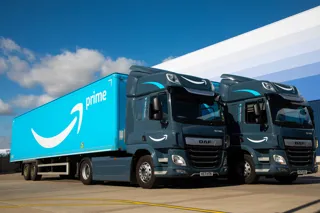Amazon plans to invest more than €1 billion (£876m) over the next five years to electrify its fleet operations across Europe, including more than £300 million in the UK.
Thousands of new electric vehicles (EVs) will more than double the size of Amazon’s European zero-emission fleet—bringing it to at least 10,000 electric delivery vans and more than 1,500 electric heavy goods vehicles (HGVs) by 2025.
Amazon already has more than 3,000 electric vans delivering packages to customers across Europe.
Andy Jassy, Amazon’s CEO, said: “Our transportation network is one of the most challenging areas of our business to decarbonise, and to achieve net-zero carbon will require a substantial and sustained investment.
“Deploying thousands of electric vans, long-haul trucks, and bikes will help us shift further away from traditional fossil fuels—and hopefully, further encourage transportation and automotive industries in Europe and around the world to continue scaling and innovating, as we will have to work together to reach our climate goals.”
Amazon has already launched micromobility hubs in more than 20 cities across Europe, including London, and expects to double that figure by the end of 2025.
Micromobility hubs are smaller, centrally-located delivery stations. In Europe’s traditionally dense cities, the hubs enable Amazon to operate new delivery methods, such as e-cargo bikes and on-foot deliveries, to bring packages to customers more sustainably.
In addition to these new vans and micro-mobility hubs and vehicles, Amazon will also invest in thousands of chargers across its European facilities. The investment will allow the company and its partners to improve fleet charging hardware.
Transport secretary Anne-Marie Trevelyan said: “Significant investments like Amazon’s today will be vital to reducing emissions and meeting our Net Zero goals, while supporting growth at the same time.
“By adding thousands of electric and zero emission vehicles to its fleet, Amazon is not only working to make their deliveries more sustainable, but also stimulating innovation across industry in the drive to cleaner transport.”
Long haul transportation is a hard-to-decarbonise sector due to the size and weight of the trucks and trailers, and the long distances they need to travel.
Electric heavy goods vehicles (eHGVs) are a promising technology, but eHGV production and charging infrastructure availability are limited. Amazon today has five eHGVs on the road in the UK and will have 20 on the road in Germany by the end of this year.
Amazon says it is using its size and scale to help spark the scaling of eHGV production so Amazon and others can more quickly transition away from diesel trucks.
With this new investment, Amazon expects to purchase and roll out more than 1,500 eHGVs in its European fleet, including more than 700 in the UK in the coming years.
To power its eHGVs, Amazon will build hundreds of specialised fast chargers across its European facilities, allowing the company to charge the vehicles in approximately two hours.
> Interested in comparing electric vehicle data? Check out our EV tool.
> Interested in ensuring the efficient use of EVs. Check out our dedicated editorial sections: Insight & policy | EV news | Charging & infrastructure | Costs & incentives | Benefit-in-kind | EV case studies | EV road tests
























Login to comment
Comments
No comments have been made yet.